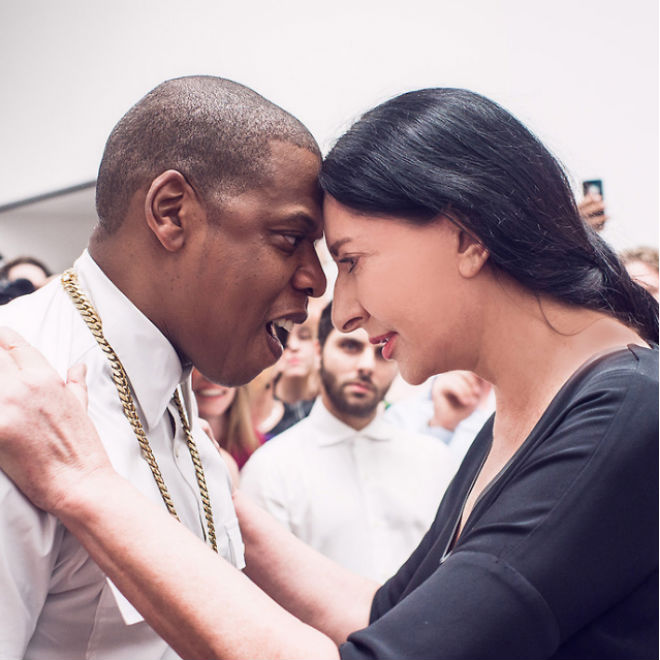By Armond White
Rappers were always welcomed by the art world–a fact of the downtown avant-garde as captured in Blondie’s 1981 Rapture music video–even before Kanye West and Jay-Z deliberately sought art world approval. Jay-Z’s new music video Picasso Baby not only crosses the Black Curtain of limited, ghettoized knowledge, it literally crosses over! And director Mark Romanek, who helmed the ultimate ghetto music video, 99 Problems (which I had featured as one of the best music videos of all time at my annual Lincoln Center music video presentation) was there to bear witness and record the transubstantiation.
 In Picasso Baby, Jay-Z materializes before a crowd of celebrities at the Pace Gallery in Chelsea. He may be holding court but the invitees behold a deity. Judd Apatow, Jim Jarmusch, Rosie Perez, Taraji P. Henson, Adam Driver, Lorna Simpson, Andres Serrano, Marina Abramavic among other attendees are famous in their fields, but Jay-Z is a Forbes-listed entertainment mogul from the world of hip-hop. If there’s one thing the art world envies more than money, it’s the automatic hipster status of Black pop which Jay-Z has got–and in Tom Ford couture. Only dreadlocks would make him look safer to such an easily threatened crowd.
In Picasso Baby, Jay-Z materializes before a crowd of celebrities at the Pace Gallery in Chelsea. He may be holding court but the invitees behold a deity. Judd Apatow, Jim Jarmusch, Rosie Perez, Taraji P. Henson, Adam Driver, Lorna Simpson, Andres Serrano, Marina Abramavic among other attendees are famous in their fields, but Jay-Z is a Forbes-listed entertainment mogul from the world of hip-hop. If there’s one thing the art world envies more than money, it’s the automatic hipster status of Black pop which Jay-Z has got–and in Tom Ford couture. Only dreadlocks would make him look safer to such an easily threatened crowd.
A lack of menace separates Picasso Baby from 99 Problems. Romanek shoots this one in color yet it looks black-and-white–as if Hova’s 99 street-life predicaments were finally neutralized. In a glorified state of success, he performs smiling; pleased to entertain, happy to be celebrated. Hip-hop “arrived” a long time ago but this crossover constitutes a personal advance. Romanek helps Jay-Z appraise himself, joining the hierarchy of financially and intellectually prized fine art.
Subtitled “A Performance Art Film,” the ten-minute Picasso Baby bites the art world incursion already made by Jay-Z’s partner-in-rhyme, Kanye West. Even though Kanye’s New Slaves outdoor video projection boldly demolished conventional performance art tactics, leaping over the museum/gallery ghetto, Jay-Z and Romanek still seek that standard. It’s one of Romanek’s formalist appropriations, this time based on last year’s documentary Marina Abramovich: The Artist is Present which chronicled Abramovich’s 2010 Museum of Modern Art performance where she held court for thousands of spectators and art groupies who lined up to sit opposite her in a chair.
Abramovich, Serbian pioneer of the peculiar “immaterial” practice known that she, since the 1970s, called “performance art,” accidentally slipped into “rock star” celebrityhood. Through Matthew Akers and Jeff Dupre’s 2012 doc, Abramovich’s power trip exposed the art world’s followers, sycophants as well as the New York freak show of oglers and exhibitionists. Her MoMA curator, Klaus Biesenbach, enthused “She did create a charismatic space, a rent in the universe.” Tearful throngs flocked to her performance the way others attend church and Romanek recreates that secular frenzy within the class-bound safety zone of invited V.I.P.s. No hoi polli or street thugs allowed.
So Picasso Baby avoids real-life cinema verite accidents. It’s a variation on concert performance (with Abramovic’s sexy maternal presence conferring approval). In the song “Heaven” from the entertaining yet curiously secular/sacred-titled Magna Carta Holy Grail CD, Jay-Z boasts that he can “turn arenas into church.” That original performance art idea recalls a long time evangelical practice, but now, at his new socio-economic level, Jay-Z seeks haughtier acceptance. (“I crash through glass ceilings/I break through closed doors.”)
This way, Picasso Baby is intended to enlarge hip-hop’s egalitarian fantasy but instead it bursts the “ brotherhood” balloon: Each celebrity-spectator shown represents our culture’s bifurcated reality. Everyone here is an arriviste. Since the 2008 coronation, its been proven that nothing pleases Black Americans more than when crossing-over becomes getting over–getting above one’s original station. Picasso Baby is all about the “getting.” Jay-Z typifies this after making several art world shout-outs (from Picasso to Jeff Koons), dubbing himself “the new Jean-Michel.” Then, in the nicest line, does a proud Papa boast: “Yellow Basquiat in my kitchen corner/ Go ahead lean on it, Blue./You own it.”
No 99-percenter shared-wealth here; patriarchy and possessiveness combine. That heart-warming family cohesion on 2001’s The Blueprint ripens (courtesy of daughter Blue Ivy) into a clever Will and Testament of family wealth. This hip-hop candor differs from politician Bill DiBlasio shamelessly exploiting his Afro-identified “Black” son; Jay-Z simply bequeaths art world privilege to his progeny. Fact is: Hip-hop never denies acquisitiveness and Picasso Baby doesn’t fake it. Jay-Z can’t help enjoying his exclusivity. Through the advantage of celebrity–and making a disingenuous spectacle of “performance art”–Jay-Z brings Basquiat back into the Black fold.
There’s no one-to-one compassion in Picasso Baby such as Abramovic displayed at MoMA or as when I saw Morrissey signing autographs and empathizing with fans at Tower Records. Jay-Z in Chelsea just grins and vamps. He’s a rapper; for him performance art is foremost about showing off. By referencing Picasso, the game-changing, innovative Spanish artist, Jay-Z’s brag of cultural knowledge and cultural reach also measures today’s short distance from the Marcy Housing Projects to a Chelsea gallery. Now he’s on intimate terms with Picasso’s autonomy and fame. Let’s hope he also questions the privileges.
Follow Armond White on Twitter at 3xchair
